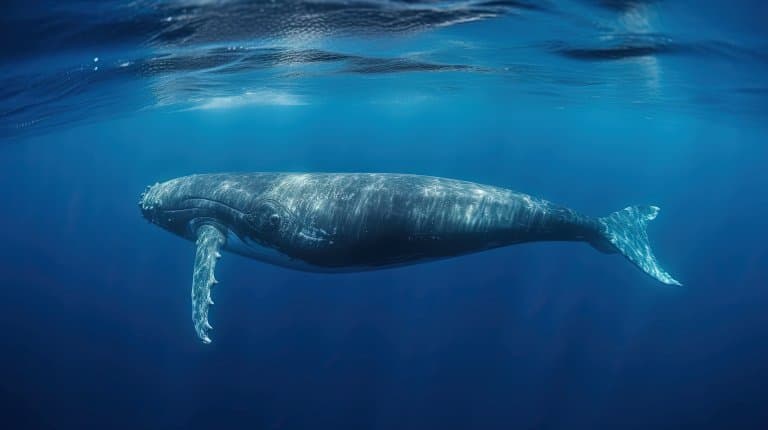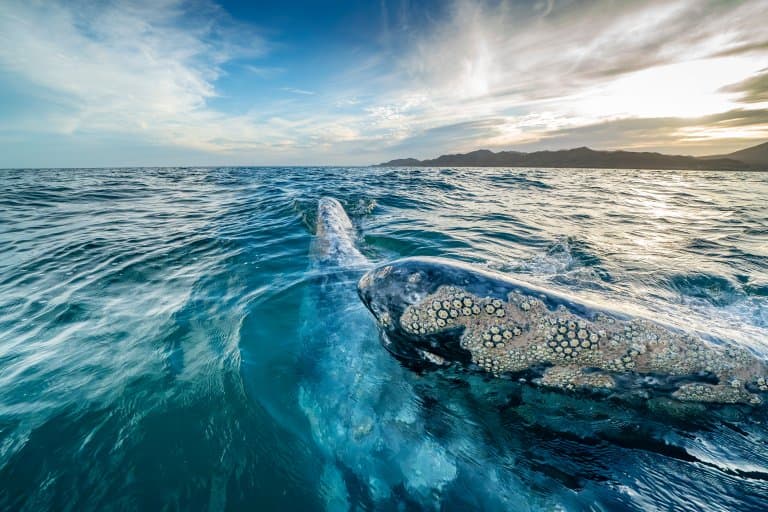Gray Whale Profile
Back when mammals re-entered the oceans, a divergence occurred. One branch used echolocation to become fast and precise hunters of the deep. These are the toothed whales.
The other branch preferred the slower pace of life; singing to one another across immense distances and gulping up big mouthfuls of tiny animals. From there, another divergence occurred.
Among the baleen whales, one species moved away from the free-floating planktonic diet and became a specialised shellfish connoisseur. Gray whales are pickier about what they eat and have become highly-adapted shellfish gulpers instead.
Gray whales are also known as ‘grey whales’, or the Pacific, Korean or California gray whale.

Gray Whale Facts Overview
| Habitat: | Shallow, coastal |
| Location: | North Pacific |
| Lifespan: | Possibly over 80 years |
| Size: | Around 15, (49ft) long |
| Weight: | Up to 40,000kg (88,000 lb) |
| Colour: | Grey to black |
| Diet: | Copepods, mollusks |
| Predators: | Orcas, humans |
| Top Speed: | Slow |
| No. of Species: | 1 |
| Conservation Status: | Least Concern (IUCN) |
Gray whales hunt along the shoreline, feeding on invertebrates that live in the sand.
This makes them easy targets for whalers, and, like so many other whale species, their numbers were unforgivably reduced by human over-consumption in the past couple of centuries.
They’re now extinct in the Mediterranean and the North Atlantic, but tentatively returning in the North Pacific, though their species is one of the most sensitive to the impacts of climate change of any rorqual.
Interesting Gray Whale Facts
1. Their common name is derived from their skin
The gray whales skin is a dark slate-gray color, but their common name comes from the gray patches and white mottling on it’s skin.
These characteristic gray-white patterns are scars left by parasites and barnacles that attach to the skin, and fall off.

2. They have a winning smile
Gray whales are rorquals, members of the largest group of baleen whales that includes such incredible animals as the blue whale. But they differ from their relatives in the quality of their baleen.
Baleen is a sort of bony curtain that hangs over the mouth of filter-feeding whales and functions to hold back the tasty stuff while pushing out all the salty water. In most baleen whales, it’s long and dark, but in Grays, it’s shorter and generally more of a bright, creamy colour.
This gives the whales a distinctive grin and sets them apart from other members of the family.
3. Gray whales are bottom-feeders
An animal’s mouth tells you a lot about its life. Primarily, what it eats. While most of the rorquals filter out plankton and small fish from open water, Grays are bottom-feeders. They’re amphipod specialists, but they’ll eat more or less any critter they can find scurrying along or attached to the sea bed.
Amphipods are similar in appearance to fleas, and these invertebrates will be supplemented in the Gray whale diet with bits of mollusc and other shellfish.
This feeding strategy has given the whale species success in its niche, but it has also created a vulnerability in modern times, as it brings the animal in close contact with humans. 1

4. They migrate over 19,000 km
The migration routes of this species are well documented, and take the animals over a 19,000km trip up and back along coastal waters seasonally.
This makes them easy to spot for shore-based whale watchers along Mexican coastlines where they spend the winter. During this time, they’ll barely eat at all, instead choosing to fatten up in the cooler Arctic waters during the summer, which means they fast for more than half of the year.
5. They might have been hunted in the Roman Empire too
This overlap with coastal human settlements has meant the whale species played an important part in prehistoric human communities. To this day, it’s hunted by native peoples in the north of its range, but during the peak of industrial whaling, it was decimated, along with most other species of large whale.
Gray whales disappeared from the North Atlantic entirely by the 18th century, and recent analyses suggest they were once common in the Mediterranean too. This same research hypothesises that there was a previous whaling industry, before the industrial revolution, that was perhaps responsible for the reduction of Gray whales around the Roman Empire. 2
6. They’re becoming skinny
Increasing temperatures in the Arctic might be affecting this cycle for the whales. Rising temperatures affect the hunter’s food source, and it’s thought that between 1999 and 2000, a third of the Gray population died of malnourishment during El Niño.
Gray whale populations are linked to the amount of time the sea ice blocks off their access to Arctic feeding grounds and the quality of the food that’s found there. While rising temperatures initially opened up longer feeding opportunities, now the increased temperatures are causing disruptions to the ecosystems that have reduced the quality of the available food there.
And this die-off never truly stopped, and the population was reduced to roughly 25% overall. Since they only feed for a portion of the year, Gray whales fatten up a hump behind their heads, and researchers are recording that over-wintering whales are showing signs of malnutrition and generally not carrying enough fat to survive.
With this round of extreme weather, the effect could be significantly higher in the coming years. The ocean as a whole is becoming an unhealthy ecosystem due to climate change and overfishing, and cases like this are worrying indicators of total ecological collapse. 3
7. Gray whales like to be groomed
Gray whales are not only sensitive to climate change, they appear to be gentle, curious animals.
Despite being old enough to remember human industrial whaling almost eradicating the species, many are known to approach boats, making eye contact with the passengers and even allowing them to be groomed.
These interactions are apparently initiated by the whales, and it’s certainly an understatement to say our species does not deserve the welcoming attitude it’s receiving from them.

8. They could fight
Whaling records describe the powerful struggle this species put up during a hunt. They were nicknamed “devil fish” on account of the fight they put up.
They’ve also been known to rush orca pods, taking on the only true apex predator on Earth. While orcas still rightfully incur the wrath of Gray whales, even calving mothers seem to have forgiven the human presence.
9. Gray whales were hunted to near extinction
And that’s truly surprising because these enormous, emotionally intelligent and gentle creatures were massacred most brutally by human whaling. By the late 19th Century, their breeding grounds were discovered, and mothers and babies alike were savaged by harpoons.
Once the population dropped to unprofitable numbers for the industry, they were ignored for a while to recover, but the advent of on-board whale processing saw a resurgence in this genocide and at their lowest, their population comprised just a few hundred.
This was not a special case among whales; fin whale populations were reduced by 99%, and between the roughly 3 million cetaceans killed, whaling still represents the most colossal eradication of any life form in terms of biomass.
It’s worth emphasising this because it’s a commonly overlooked driver of climate change. Along with the loss of Pleistocene megafauna on land, declines in whale biomass have released an average of 33 tons of CO2 per whale.
Restoring whale populations to their former glory may be one of the most significant drives to fight against climate change, and would boost ocean biodiversity immeasurably in the process.
10. They still get tangled in nets
This is unlikely to ever happen with the present nature of human consumption. Industrial fishing not only wipes out whale food from the ocean and fills the atmosphere with under-regulated, dirty-burning fuel, but it also directly wipes out whale populations.
Over 300,000 cetaceans are killed as by-catch by the fishing industry every year. That’s more than 300 times the amount of whales Norway will be lambasted for slaughtering on purpose, for eating, this year.
This destruction is directly caused by industries supplying Western consumption demand. While only 37% of the world relies on seafood for survival, over 80% of people in developed countries consume it.
As sea life becomes depleted, yields drop. This results in more ships heading out, bringing more nets, and killing more wildlife as bycatch. 80% of human-caused, Gray whale fatalities in the North Pacific were caused by such entanglements in fishing nets.

11. The gray whale is the sole living species in its genus
It’s genus ‘Eschrichtius’ also contains the now extinct Akishima whale. Bones of this species were found in 1961 in a riverbed in Akishima, Tokyo, which formed the common name, Akishima whale.
Based upon these bones, it’s thought the total length of the Akishima whale was once 12 metres (39 feet).
The bones are believed to be from around 1.77–1.95 million years ago (mya) in the Early Pleistocene.
Gray Whale Fact-File Summary
Scientific Classification
| Kingdom: | Animalia |
| Phylum: | Chordata |
| Class: | Mammalia |
| Order: | Artiodactyla |
| Family: | Eschrichtiidae |
| Genus: | Eschrichtius |
| Species: | Eschrichtius Robustus |
Fact Sources & References
- “Gray whales learn daring feeding strategy in Puget Sound: Digging for ghost shrimp at high tide”, The Seattle Times.
- Ana S. L. Rodrigues (2018), “Forgotten Mediterranean calving grounds of grey and North Atlantic right whales: evidence from Roman archaeological records”, The Royal Society.
- “Gray whales are dying along the Pacific coast”, CNN.
